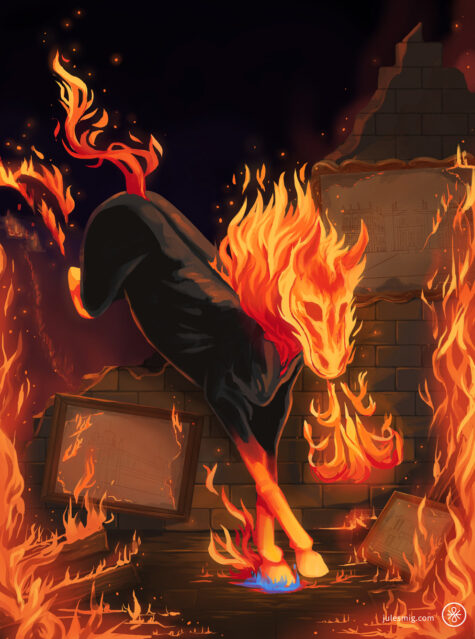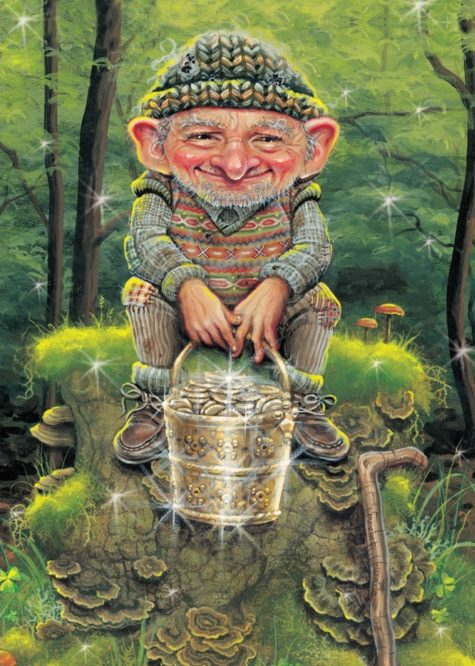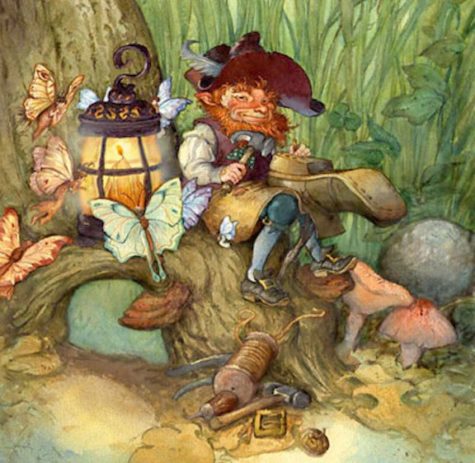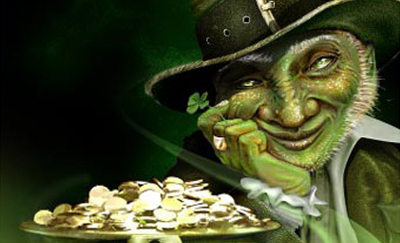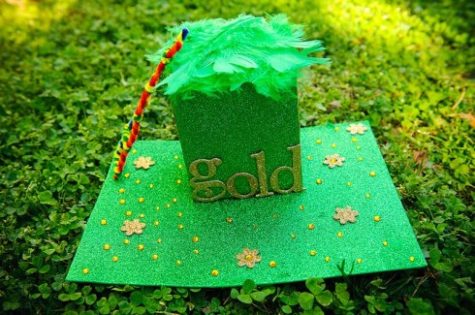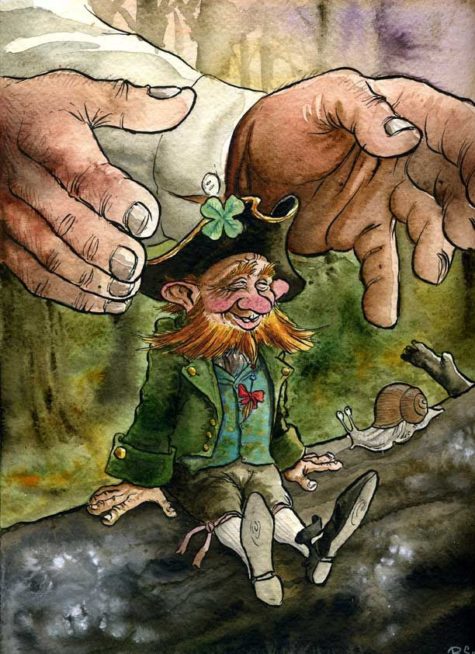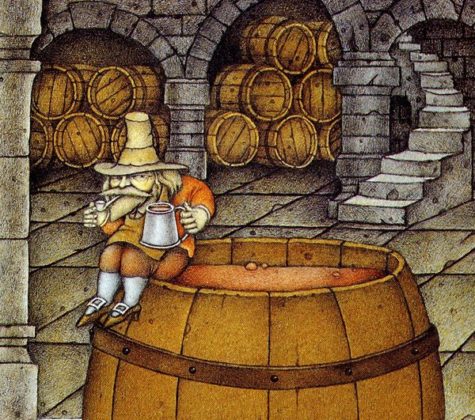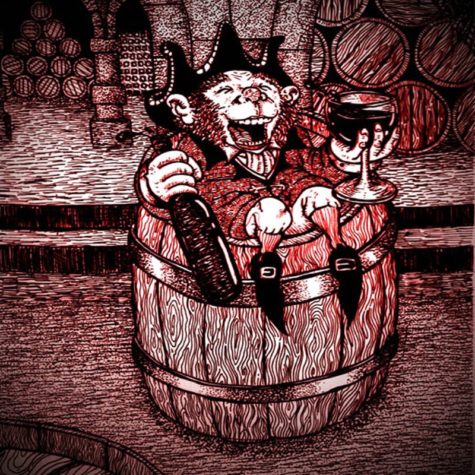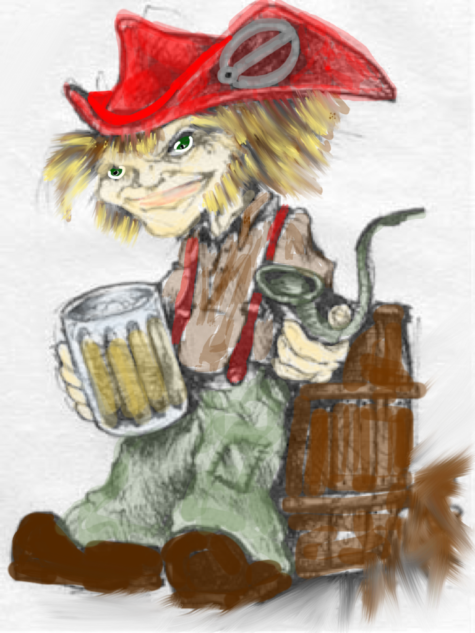Demons and Troublemakers
The Headless Mule or Mula-Sem-Cabeça, is a mythical character in Brazilian folklore. The Mule’s appearance varies greatly from region to region. Its color is most commonly given as brown, sometimes as black. It has silver (or iron) horseshoes that produce a hideous trotting sound, louder than any horse is capable of producing.
The legend of the mula tells of a girl or woman who was cursed for having relations with a priest. As punishment for her part in a man of God’s sin, she is condemned to transform into a wild mule with fire in place of a head, shooting flames from its nonexistent nostrils and stampeding through villages at night. In the morning, she reverts to her human form, waking up naked and unable to remember a thing.
Transformation usually occurs at a crossroads. Depending on the source the headless mule may have a placeholder head and mane, made of the fire it spews, to which a red-hot iron bridle is tied.
Despite being headless, the Mule still neighs (usually very loud), and sometimes it moans like a crying woman. Is said to produce a piercing, terrifying noise during its rampage, and the clattering of its gold or silver shoes strikes fear into all who hear it. If you get too close, it might kick you into the afterlife.
To successfully hide from the mula, you must ensure specific body parts are concealed from its sight, as it seems to enjoy eating eyes, thumbs, teeth, etc., depending on which version of the legend you recall while in the process of dying of fright.
The transformation can be reversed temporarily by spilling the mule’s blood with the prick of a needle or by tying her to a cross. In the first case, transformation will be prevented while the benefactor is alive and lives in the same parish in which his feat was accomplished. In the second case the woman will remain in human form until the sun dawns, but will transform again the next time.
A more stable removal of the curse can be achieved by removing the bridle, in which case the woman will not shape shift again while the benefactor is alive. Tying the bridle back to the woman’s mouth will return the curse.
Removal of the curse is a great relief for the woman because the curse includes many trials, so the grateful woman will usually repent her sins and marry the benefactor. In any case, when the mule changes back to human form the accursed woman will be completely naked, sweated, and smelling of sulfur.
A person who encounters the mule should not cross its path, or the mule will follow the offender and trample him down. Instead, one should either be brave enough to remove the bridle or spill its blood, or else just lay face down on the ground, covering teeth and nails (as well as anything that shines) and the mule will hopefully fail to notice the stranger’s presence and trot away (because it has poor vision).
Some versions of the legend curse the priest instead of the woman, usually following a twist where the aforementioned relations are violently one-sided in the priest’s favor. Some also say the mula is a girl who lost her virginity outside of marriage. A third, more fantastic version involves a queen who had a bad habit of digging up kids’ graves and eating the corpses… until the king caught her in the act, whereupon she transformed into the mula and charged headlong into the night.
Sources:
- Origin: Ireland
- Manifestation: Leprechauns are described as small wizened men wearing a shoemaker’s leather apron.
The stereotype of the Leprechaun involves lucky charms and pots of gold at the end of the rainbow. If captured by a human, they often grant three wishes in exchange for their freedom.
Leprechauns are highly commercially modified spirits; their image used to sell breakfast cereal, beer, and anything even remotely Irish. In recent years, Leprechauns, re-envisioned as “evil Fairies” have evolved into villains of horror movies; however this distorted image has no relation whatsoever to true Leprechauns who may be grouchy but are by no means vicious killers.
True Leprechauns are members of the Fairy folk, a type of sidhe. They are unusual because, in a realm dominated by females, Leprechauns are virtually exclusively male spirits.
The name Leprechaun derives from the Gaelic leigh brog “one shoemaker.” He is a cobbler, the only professional sidhe. While the other sidhe are out dancing and reveling, the Leprechaun is hard at work. He is, however, always seen working on only one shoe rather than a pair, which may be a shamanic reference.
References to shoes, especially one shoe, are often oblique references to shamanism. Ancient shamanic seances were often performed with one shoe on and one shoe off or featured dance steps that mimicked limping.
He works on shoes continually, with time off only for an occasional spree. The Leprechaun is fabulously wealthy: he buries his treasure in pots and is reputedly a skillful but not always nice practical joker. He may be invoked for financial aid.
Like other Irish fairies, Leprechauns may be derived from the Tuatha Dé Danann. Leprechaun-like creatures rarely appear in Irish mythology and only became prominent in later folklore.
- Interesting factoid: Leprechaunism is another name for Donohoe Syndrome, a rare genetic disorder characterized by delayed or diminished growth and facial features perceived as elfin.
According to Yeats, the solitary fairies, like the Leprechaun, wear red jackets, whereas the “trooping fairies” wear green. The Leprechaun’s jacket has seven rows of buttons with seven buttons to each row. On the western coast, he writes, the red jacket is covered by a frieze one, and in Ulster the creature wears a cocked hat, and when he is up to anything unusually mischievous, he leaps on to a wall and spins, balancing himself on the point of the hat with his heels in the air.
According to McAnally:
He is about three feet high, and is dressed in a little red jacket or roundabout, with red breeches buckled at the knee, gray or black stockings, and a hat, cocked in the style of a century ago, over a little, old, withered face. Round his neck is an Elizabethan ruff, and frills of lace are at his wrists. On the wild west coast, where the Atlantic winds bring almost constant rains, he dispenses with ruff and frills and wears a frieze overcoat over his pretty red suit, so that, unless on the lookout for the cocked hat, ye might pass a Leprechawn on the road and never know it’s himself that’s in it at all.
This dress could vary by region, however. In McAnally’s account there were differences between Leprechauns or Logherymans from different regions:
- The Northern Leprechaun or Logheryman wore a “military red coat and white breeches, with a broad-brimmed, high, pointed hat, on which he would sometimes stand upside down”.
- The Lurigadawne of Tipperary wore an “antique slashed jacket of red, with peaks all round and a jockey cap, also sporting a sword, which he uses as a magic wand”.
- The Luricawne of Kerry was a “fat, pursy little fellow whose jolly round face rivals in redness the cut-a-way jacket he wears, that always has seven rows of seven buttons in each row”.
- The Cluricawne of Monaghan wore “a swallow-tailed evening coat of red with green vest, white breeches, black stockings,” shiny shoes, and a “long cone hat without a brim,” sometimes used as a weapon.
In a poem entitled The Lepracaun; or, Fairy Shoemaker, 18th century Irish poet William Allingham describes the appearance of the Leprechaun as:
…A wrinkled, wizen’d, and bearded Elf,
Spectacles stuck on his pointed nose,
Silver buckles to his hose,
Leather apron — shoe in his lap…
The modern image of the Leprechaun sitting on a toadstool, having a red beard and green hat, etc. is clearly more modern invention or borrowed from other strands of European folklore. Films, television cartoons and advertising have popularized a specific image of Leprechauns which bears little resemblance to anything found in the cycles of Irish folklore. It can be considered that the popularized image of a Leprechaun is little more than a series of stereotypes based on derogatory 19th-century caricatures.
Catching A Leprechaun
Leprechaun traps are crafts made, typically in elementary school or by families with small children, to celebrate Saint Patrick’s Day. Leprechaun trapping can be compared to leaving cookies out for Santa Claus on Christmas Eve. The traps are set up the night before St. Patrick’s Day, and children awaken to discover signs that leprechauns have visited the trap.
The traps are typically made out of common household items that can be easily found or purchased. The traps are typically green and gold and feature the stereotypical leprechaun items: gold coins, rainbows, top hat and four leaf clover. A simple google search will reveal literally hundreds of DIY Leprechaun trap ideas.
According to the tradition, one must believe leprechauns are real to trap one. It is also believed that leprechauns love gold and trickery, and may steal or hide items unless captured, pleased, or scared away. Once trapped, Leprechauns may grant three wishes, and in many of the folklore stories, those lucky enough to catch one are tricked, and made foolish wishes which they lived to regret.
In most cases, children return to the trap with signs of a leprechaun visiting rather than a leprechaun itself. There might possibly be chocolate coins, and small treasures left in their bottom drawers.
If you Catch A Leprechaun
If you get lucky and manage to catch a leprechaun you need to be smarter than him or else you will be easily tricked which can have damaging results, never take your eye off him or he will vanish.
A captured leprechaun will grant you three wishes or a gold coin to bribe his way to freedom but this is when things can go terrible wrong if the wrong decisions are made.
- Use your 3 wishes wisely
Many of an Irish man who thought he could out smart an Irish leprechaun had selected the three wishes and would either go insane trying to think of what to wish for or their wishes would back fire with something bad happening.
One common story was of Seamus in County Mayo who wished to be the richest man on a tropical island. However, when his wish came true he suddenly realized that there were no shops or pubs on the island to spend his money or even people to talk with. Unfortunately Seamus became bored after a few hours on the Island and had to waste his third wish to return to Ireland. This could be how the phrase “luck of the Irish” originated from.
One of the biggest tips an Irish person can give anyone is to never listen to what the Irish leprechauns says, no matter what. The leprechauns are great mind players and will say anything to confuse you. You’ll make the wrong wishes, although he is smart he can be fooled.
- Never trust an Irish Leprechaun
Irish leprechauns are devious little creatures and will do anything to escape from man so they should never be trusted. Some say angry leprechauns are more common than a friendly one but this is very untrue as Irish leprechauns are very friendly but tend to dislike humans who always seem to chase them for wishes and pots of gold.
If you ever spot a leprechaun you may be better off to pass him by without taking notice, you can end up in more trouble than its worth if decide to chase them as the people of Ireland only know to well. Unfortunately with cities in Ireland expanding the poor wee leprechauns are being driven further underground away from man, taking their rainbows with them.
Sources:
- Encyclopedia of Spirits
- Wikipedia
- You’re Irish
Clurichauns may or may not be the same type of spirit as Leprechauns. If not, they are closely related. Like Leprechauns, Clurichans are virtually exclusively male. The Clurichaun may be the nocturnal form of the Leprechaun, out on a bender after a hard day’s work. Alternatively, some perceive Clurichauns to be Leprechauns lacking a work ethic.
Unlike hardworking, wealth-accumulating Leprechauns, Clurichauns spend all their time drinking. They are virtually always soused although they allegedly retain their good manners, unlike the reputedly sometimes surly Leprechaun. Clurichauns come out at night to drink, party and play pranks on people.
The folklorist Nicholas O’Kearney described the Clurichaun in 1855 as follows:
“ The Clobhair-ceann was another being of the same class: he was a jolly, red-faced, drunken little fellow, and was ever found in the cellars of the debauchee, Bacchus-like, astride of the wine-butt with a brimful tankard in hand, drinking and singing away merrily. Any wine cellar known to be haunted by this sprite was doomed to bring its owner to speedy ruin.”
Katharine Briggs stated that he was “a kind of buttery spirit, feasting himself in the cellars of drunkards or scaring dishonest servants who steal the wine.”
He is also described as a trickster and practical joker, and a disturber of order and quietness in a household, making noise day and night. Despite his often troublesome nature, the Clurichaun takes special care of the family to whom he has attached himself, endeavoring to protect their property and lives provided he is not interfered with. This dual nature makes him similar to the domestic hobgoblin.
Besides his love of drinking, the Clurichaun also enjoys pipe smoking, and the small disposable clay pipes known as “fairy pipes” that are often found while digging or plowing are said to belong to him. He also knows the secret of making beer from heather.
In olden days, many were butter thieves. They still like to raid the pantry.
The only occupation for which the Clurichaun displays enthusiasm is as guardian of wine and liquor cellars. The Clurichaun will protect your cellar from thieves and can allegedly prevent wine from spoiling and bottles from breaking or leaking. Simply request his presence and explicitly leave him a sample of whatever you have in stock. Leave him offerings on a regular basis lest he decide to begin serving himself. (He may anyway.)
The Clurichaun is sometimes portrayed carrying a jug of ale or wearing a leather apron with hammer in hand, whistling as he works. He also carries a magical purse (or sometimes a pewter beggars cup) with varying properties. It may contain a shilling (known as the “lucky shilling” or spre na skillenagh) that always returns to the purse no matter how often it is spent, or it may always be full of money, and for this reason mortals will often try to capture the Clurichaun . Even if he is caught he has the power to vanish if he can make his captor look away even for an instant.
He frequently carries two such purses, one containing the magic shilling and the other containing a normal copper coin, and if captured he will present the latter before vanishing. Like the Leprechaun he is sometimes said to have knowledge of hidden treasure and can be forced to reveal its location. In such instances one of his tricks is to create the illusion of multiple treasure markers so that the seeker will not know its exact whereabouts.
Clurichaun Stories
In the folktale “The Haunted Cellar”, recorded by Thomas Crofton Croker in 1825, a Clurichaun named Naggeneen haunts the wine cellar of an Irish lord, drinking everything in sight and playing frightening pranks on the servants.
He is described as a little man measuring six inches in height with a face like a withered apple. He has twinkling eyes and a nose that is red and purple from heavy drinking. He wears a red nightcap, a short leather apron, light blue stockings, and shoes with large silver buckles. When he is discovered by the master of the house, Naggeneen talks him out of moving elsewhere by implying that he would simply move with him.
Other descriptions have him wearing red like other solitary fairies.
In another tale, “Master and Man”, a young man named Billy Mac Daniel is on his way home one winter night when he is offered a glass of liquor by a Clurichaun to warm himself. He takes the drink but when he refuses to pay for it he is compelled by the Clurichaun to serve him for seven years and a day. Billy, however, is eventually able to break his servitude by invoking the blessing of God.
In this story, the Clurichaun is able to pass through keyholes to invade homes and wine cellars and can transform bog rushes into horses to be used as mounts. Clurichauns can also fly through the air on rushes similar to witches and their broomsticks.
Sources:
- Encyclopedia of Spirits
- Wikipedia
